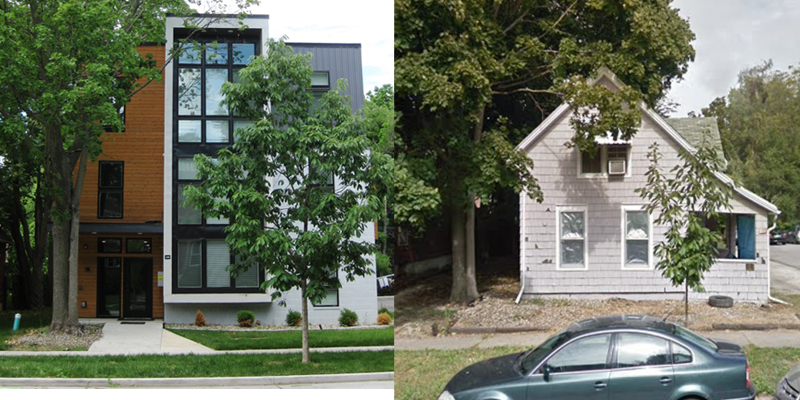When it comes to where you live, your city’s zoning regulations will determine a lot about the feel of your neighborhood. Will a ten-story apartment building be permitted to loom over your single-family home? Will a cement factory or industrial park be allowed near your four-unit apartment building? Zoning regulates what kinds of residential or commercial structures may be built and where they may be built.
Zoning regulations also dictate the footprint your dwelling may have — that is, how large a building may be permitted on a given size plot of land. Zoning also determines more aesthetic and practical issues, such as how much green space will be required to surround the dwelling, how far the structure has to sit back from the sidewalk, or how many parking spaces are required.
In recent years, there have been national trends in major urban areas to address economic disparities and offset unregulated sprawl on the fringes through something called incremental zoning. Incremental zoning permits higher density housing and decreases mandatory lot sizes in older historic centers that have traditionally been single-family.
Are such policies applicable and useful to Champaign-Urbana? We argue no.
These issues are pertinent because Champaign is moving forward with — and Urbana might well follow — this new zoning policy of incremental zoning. Under the proposed zoning, Champaign would permit four- and six-unit apartment buildings in current single-family zoning districts in the older parts of town, authorize building on smaller lots, decrease mandatory setbacks, and allow accessory dwelling units (such as a converted garage) on a single-family lot.
In some locations incremental zoning appears to be an equitable and sustainable policy for cities to adopt. It aims to make living in a residential neighborhood more affordable, and claims to offset sprawl by promoting infill. A more nuanced analysis shows that the policy has serious shortfalls depending on the specifics of a given locale.
Incremental zoning, also known as upzoning, just doesn’t work in Champaign-Urbana. Let’s take a look.
First, consider the issue of equitable housing policies. Imagine if every worker at Marketplace Mall had to drive at least a half hour to work because no rental properties were located any closer to the mall. That’s the situation in some suburbs of Chicago and other large cities that gave rise to the notion of “inclusionary zoning.”
We have no such situation in Champaign-Urbana. Yet, many Champaign council members and city planning staff support upzoning single-family zoned areas to allow apartment buildings. It’s not all areas; just the places where houses are older and less expensive to acquire. More expensive, exclusive, single-family neighborhoods will remain untouched.
Homeowners on the block object because they feel a zoning change is breaking the promise on which they relied when they bought their homes. And those of us who care about affordable housing don’t like to see a two-bedroom house that rents for $700 a month replaced by an apartment building where a two-bedroom unit rents for $1400 monthly.
Today’s inclusionary zoning is yesterday’s gentrification, and before that, it was urban renewal. All are strategies that have actually reduced the already inadequate supply of rental housing that is affordable to low wage earners like employees at the mall.
If the real goal was to bring about more equality, the City would upzone all single-family residential neighborhoods, as Minneapolis has done, and not limit upzoning to the historic center. Let’s acknowledge that newer developments with Homeowner Association covenants are merely exclusionary zoning in another guise. Downtown infill won’t reverse such housing disparities.
The bottom line:
- the planning strategy of multi-family housing helping lower income people is only applicable to communities with little or no rental opportunities;
- rents for new apartments, wherever they are located, are higher than rents at the properties demolished to make room for new construction;
- housing inequities will continue with single-family residential developments thriving on the outskirts.
Second, consider claims of sustainability: Issues of smart growth won’t be solved simply by slapping down higher density units downtown. Imagine an hour-plus commute to your job downtown, as might occur in the Bay Area or DC. Then consider the triviality of a five-mile commute to the major employer in C-U. No one in C-U is going to move downtown simply for a less arduous commute. Claiming that infill offsets sprawl doesn’t compute.
To more fully and honestly embrace sustainable growth, Champaign and Urbana should promote compact building design by limiting the maximum sizes of lots in all new development and promoting net-zero construction both in town and on the fringes, where larger homes on larger lots dominate the development landscape.
Let’s face it: it’s all about money. The motive for upzoning is to increase property tax revenue to pay for government services. We certainly support government services and increasing property tax revenue to pay for them, but it does not have to be at the expense of neighborhoods or housing for lower income workers.
And the other beneficiaries? Upzoning is a developer’s bonanza. You can bet that developers will be eager to buy older homes and tear them down to build new apartments where they’ll charge high rents. Sadly, the losers will be those most in need of affordable housing, as well as home-owners in the newly upzoned parts of towns.
Esther Patt is Director of CU Tenant Union, and long-time advocate for affordable housing.
Liz Cardman is a long-time advocate for historic neighborhoods that grow sensibly and maintain livability.








